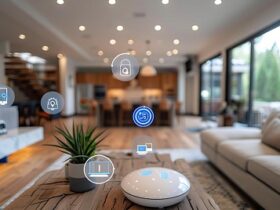In our rapidly evolving world, the concept of sustainable living has become paramount. One area where this notion has gained significant traction is in the realm of home automation. Sustainable smart homes, equipped with green technologies, are at the forefront of the movement towards eco-friendly living. In this article, we delve into the evolution, components, benefits, challenges, and future trends of sustainable smart homes.
The Evolution of Home Automation
The journey towards smart homes has been a fascinating one. Initially rooted in basic home security systems, home automation has transformed into a sophisticated network of interconnected devices. From the invention of the first home security system in the early 20th century to the current era of AI-powered smart homes, the evolution has been monumental.
Key Components of Sustainable Smart Homes
Sustainable smart homes incorporate various green technologies aimed at reducing environmental impact. Energy-efficient lighting, smart thermostats, renewable energy integration, and water conservation systems are essential components that contribute to the sustainability of a smart home.
Benefits of Sustainable Smart Homes
The advantages of sustainable smart homes are manifold. Not only do they contribute positively to the environment by reducing carbon footprints, but they also offer significant cost savings for homeowners. Additionally, these homes often see an increase in property value due to their eco-friendly features.
Challenges in Implementing Green Technologies
While the benefits are clear, challenges exist in the widespread adoption of sustainable smart homes. Initial costs, technological complexities, and the need for consumer awareness and acceptance pose hurdles to the seamless integration of green technologies.
Innovative Solutions in Sustainable Smart Homes
Addressing these challenges requires innovative solutions. AI-powered energy optimization, IoT integration for seamless automation, and the use of sustainable materials in construction are some of the ways in which the industry is overcoming obstacles to create truly eco-friendly homes.
Future Trends in Green Home Automation
The future holds exciting prospects for sustainable smart homes. Advancements in technology, potential regulatory changes, and consumer-driven innovations are poised to shape the landscape of green home automation.
How Sustainable Smart Homes Contribute to a Greener Future
The impact of sustainable smart homes goes beyond individual households. These homes play a crucial role in reducing overall carbon footprints, conserving natural resources, and influencing societal behavior towards more sustainable living practices.
Guidelines for Building a Sustainable Smart Home
For those considering embracing the green revolution in home automation, guidelines on choosing the right technologies, incorporating eco-friendly construction practices, and ensuring proper maintenance and upgrades are crucial for long-term sustainability.
Collaborations and Partnerships in the Industry
The collaboration between tech companies and environmental organizations, along with government initiatives supporting green home projects, is instrumental in driving the adoption of sustainable smart homes on a larger scale.
Addressing Common Myths and Misconceptions
Debunking myths about the cost of sustainable smart homes and clarifying misconceptions about the complexity of green technologies is essential to encourage wider acceptance and adoption.
The Role of Sustainable Smart Homes in Urban Planning
The integration of sustainable smart homes into urban planning is a crucial step towards creating eco-friendly and resilient cities. By incorporating green homes into city plans, we can contribute to the development of sustainable urban environments.
FAQs
No, sustainable smart homes offer benefits to all homeowners, including cost savings and increased property value.
Maintenance needs vary but are generally manageable, and advancements in technology aim to reduce maintenance requirements.
Consult with professionals to assess your home’s compatibility and explore options for gradual integration.
No, sustainable smart homes can be implemented in various settings, including suburban and rural areas.
Some regions offer incentives; check with local authorities or environmental agencies for information on available programs.
Conclusion
Sustainable smart homes with green technologies are not just a trend but a necessity for a sustainable future. The benefits they offer in terms of environmental impact, cost savings, and increased property value make them a compelling choice for homeowners. As technology continues to advance, the widespread adoption of sustainable smart homes is poised to become a cornerstone in the movement towards a greener and more sustainable way of living.











Find Us on Socials